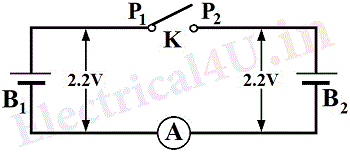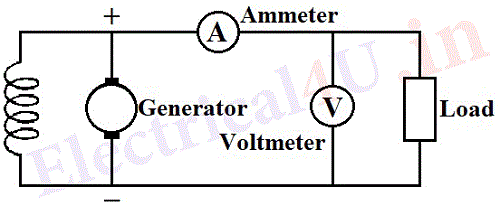Potential – The potential of a body may be defined as the work done in joules to bring a unit electric charge from infinity to the body. It will be observed that the word infinity has been used in its definition and it is difficult to find an infinite point. Thus it is practically impossible to determine the potential of the body, but for all purposes the potential is usually referred to earth which is assumed to be at zero potential.
It is occasionally that the potential of the body is required, in practice only potential difference between any two points is of quite interest.
Potential Difference. It has already been mentioned that for the electrons to have motion in a definite direction, its two ends must be kept at different potentials, or in other words some electric pressure must be applied to drive the electrons. This electric pressure can be compared with water pump which drives water in water pipes by means of creating pressure difference. In current electricity the electric pump is a battery of dry cells or of lead acid cells or a generator. Thus the potential difference may be defined as that which causes current to flow in the closed circuit.
So, it can be derived that if there is a potential difference, there is current; no potential difference no current. It can again be well compared with mechanical analogy.

Consider a water reservoir as shown in Fig. 1 connected to tank through a valve V. Let the outlet valve V1 of the tank be closed. If value V is opened the water in the tank will rise to the level of the water in the reservoir. There will not be any further rise of water level in tank due to the reason that the water pressure in the two tanks has become the same. If valve V1 is opened and the water in the tank is allowed to flow out, the water from reservoir will start coming, because the pressure in the tank has decreased.

Now consider batteries B1 and B2, the negative terminals of which are connected together through a copper wire and ammeter while their positive ends are connected through key K. The point P1 of battery B1 is at a potential of 2.2V higher than its negative terminal; similarly point P2, of battery B2, is at a potential of 2.2V higher than its negative terminal. Now if the key K is connected, it will be observed from the ammeter that there is no current in the circuit due to the reason that the potential of the two batteries is same. Thus this condition of Fig. 2 is similar to that of Fig. 1.
If one of the batteries, B2 is of higher potential say of 4 V, the connection of key K will cause a current to flow. Hence for flow of water or for flow of current a difference of pressure or potential is required. The potential difference is measured with the help of a voltmeter which is an instrument connected across the positive and negative terminals of the source, while the current is measured with the help of an ammeter connected in series with the line.

Fig.3 represents the method of measurement. It should be noted that
1. Voltmeter is an instrument of large resistance
2. Ammeter is an instrument of low resistance
Also in electrostatics the potential difference between two points has been defined as equal to the amount of work done in moving a unit charge from one point to the other. Similarly, in order that a continuous current may flow through a conductor, there must be a potential difference maintained between its ends, which requires a continuous supply of energy from a battery or a generator; whatever energy is expended in driving the electrons reappears as heat. Its unit is Volt.
In MKS units the potential difference between two points is one volt if the energy transformed is one joule when one coulomb of electricity passes between these points.
International Volt – It is defined as that potential which when applied to a conductor of 1 international unit of resistance, produces a current of one international ampere. Its value is equal to 1.00049 volts.
